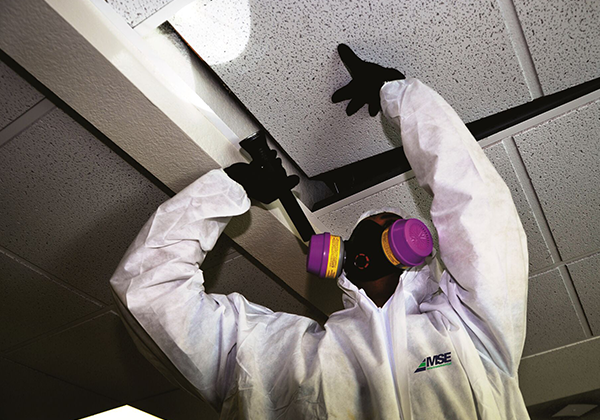Asbestos Testing: Essential Actions for a Safe Living Atmosphere
Asbestos Testing: Essential Actions for a Safe Living Atmosphere
Blog Article
The Complete Process of Accredited Asbestos Testing to Make Sure Residential Property Compliance
In the world of residential property administration and conformity, the procedure of accredited asbestos testing stands as a crucial element to guarantee the safety and well-being of owners. Comprehending the intricate actions entailed in this testing protocol is vital for homeowner and supervisors alike. From the initial analysis to the last analysis of results, each phase plays an important duty in determining the visibility of asbestos within a property. Let's check out how this precise process unfolds to guarantee adherence to stringent policies and guard against prospective wellness hazards.
Accredited Asbestos Screening: Initial Assessment
In carrying out the initial analysis for accredited asbestos screening, a meticulous exam of the property's products is crucial to properly identify prospective asbestos-containing materials. Special interest is offered to materials that are vulnerable to damage or disturbance, as these situations can launch damaging asbestos fibers into the air.
Certified asbestos assessors adhere to rigorous procedures set by regulative bodies to ensure the accuracy and integrity of the testing procedure. By meticulously documenting findings and utilizing innovative screening approaches, assessors can give homeowner with a comprehensive report outlining the existence of asbestos, if any type of, and the suggested steps for reduction or elimination. This first assessment establishes the structure for succeeding actions to address asbestos issues and make sure the safety and security and compliance of the property.
Example Collection Treatments for Asbestos Examining
Reliable example collection treatments are vital in guaranteeing accurate asbestos testing results and compliance with governing standards. When accumulating samples for asbestos screening, it is important to adhere to stringent procedures to minimize the risk of contamination and make certain the reliability of the outcomes.
Firstly, it is necessary to identify the thought asbestos-containing products (ACMs) and focus on sampling areas based on factors such as the material's condition, ease of access, and capacity for disruption. Asbestos Testing. Examples need to be gathered from various locations within the building to offer a comprehensive assessment of asbestos existence
During example collection, accredited professionals must use ideal personal safety devices (PPE) to guard versus asbestos direct exposure. They need to use clean tools, such as non reusable handwear covers and plastic sheeting, to stop cross-contamination between examples. Samples must be very carefully collected using a specified technique, such as damp cleaning or coring, and safely secured in closed containers to maintain their honesty during transport to the laboratory for evaluation.
Research Laboratory Analysis Process for Asbestos Samples
Upon completion of the sample collection procedure, the asbestos examples are meticulously carried to certified laboratories for precise evaluation. At the laboratory, trained technicians linked here take care of the samples with extreme treatment to stop any kind of cross-contamination or example deterioration. The very first step busy evaluation process is example preparation, where the gathered samples are carefully processed to draw out the asbestos fibers. Asbestos Testing. This action is critical to ensure exact cause the subsequent analysis.

When the evaluation is full, an in-depth report is generated, detailing the findings and validating whether asbestos is present, the kind of asbestos fibers identified, and the focus degrees. This info is critical for property owners to take the essential steps to make sure compliance with asbestos regulations and guard the health and wellness of occupants.

Reporting and Interpretation of Asbestos Examination Outcomes
Accredited asbestos screening research laboratories provide comprehensive records that supply vital insights right into the presence, type, and focus degrees of asbestos fibers discovered in samples collected from residential or commercial properties. These reports are necessary for homeowner and supervisors to recognize the threat postured by asbestos and make educated choices regarding its administration or removal. The records usually include information on the methods utilized for testing, the locations where samples were taken, the sort of asbestos determined (such as chrysotile, amosite, or crocidolite), and the concentration degrees of asbestos fibers detected.
Interpreting these results requires competence to analyze the potential wellness risks connected with asbestos direct exposure, figure out the proper training course of activity, and guarantee regulatory conformity (Asbestos Testing). Depending upon the findings, referrals may range from continued tracking and maintenance to encapsulation or complete asbestos reduction. Homeowner must very carefully examine these reports and speak with asbestos specialists to develop a thorough prepare for addressing any asbestos issues recognized
Making Sure Building Compliance With Asbestos Rules
To keep adherence with asbestos guidelines, residential or commercial property proprietors have to carefully execute procedures to make sure conformity with suitable legislations and guidelines. Once asbestos is recognized, property owners need to adhere to asbestos monitoring plans that synopsis correct containment, removal, or encapsulation procedures to protect against direct exposure and spread of asbestos fibers.
Homeowner need to supply asbestos understanding training to staff members and passengers to decrease the danger of asbestos direct exposure and make sure correct handling of products that might contain asbestos. In addition, it is important to remain educated regarding any type of updates or modifications in asbestos regulations to change administration methods appropriately. By proactively resolving asbestos compliance demands, homeowner can produce a secure atmosphere for occupants and reduce prospective legal and health risks linked with asbestos direct exposure.
Final Thought
In conclusion, approved asbestos testing is an essential procedure for guaranteeing residential property conformity with laws. The initial analysis, example collection procedures, laboratory evaluation, and analysis of results are very important steps in this process. By following these procedures, homeowner can recognize and review address any kind of asbestos risks existing, shielding the wellness and safety and security of occupants and keeping compliance with governing requirements.
Report this page